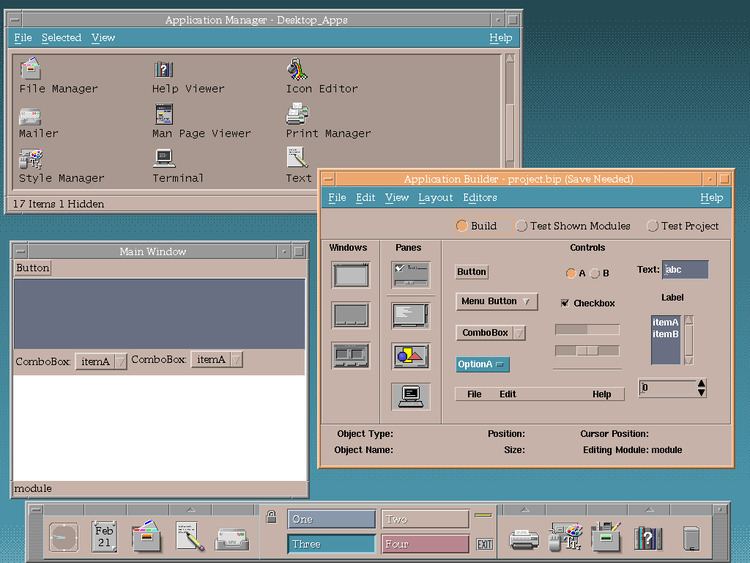 | ||
Initial release June 1993; 23 years ago (1993-06) Stable release 2.2.4 / June 19, 2016; 8 months ago (2016-06-19) Repository sourceforge.net/p/cdesktopenv/code/ci/master/tree/ Operating system | ||
The Common Desktop Environment (CDE) is a desktop environment for Unix and OpenVMS, based on the Motif widget toolkit. It was part of the UNIX98 Workstation Product Standard, and was long the "classic" Unix desktop associated with commercial Unix workstations.
Contents
- Early development
- Systems using early CDE
- Proprietary licensing
- Release under the GNU LGPL
- CDE project developments
- References
After a long history as proprietary software, CDE was released as free software on 6 August 2012, under the GNU Lesser General Public License, version 2 or later. Since its release as free software, CDE has been ported to Linux and BSD derivatives.
Early development
Hewlett-Packard, IBM, SunSoft, and USL announced CDE in June 1993 as a joint development within the Common Open Software Environment (COSE) initiative. Each development group contributed its own technology to CDE:
After its release, HP endorsed CDE as the new standard desktop for Unix, and provided documentation and software for migrating HP VUE customizations to CDE.
In March 1994 CDE became the responsibility of the "new OSF", a merger of the Open Software Foundation and Unix International; in September 1995, the merger of Motif and CDE into a single project, CDE/Motif, was announced. OSF became part of the newly formed Open Group in 1996.
In February 1997, the Open Group released their last major version of CDE, version 2.1.
Red Hat Linux was the only Linux distribution to which proprietary CDE was ported. In 1997, Red Hat began offering a version of CDE licensed from TriTeal Corporation. In 1998, Xi Graphics, a company specializing in the X Windowing System, offered a version of CDE bundled with Red Hat Linux, called Xi Graphics maXimum cde/OS. These were phased out, and Red Hat moved to the GNOME desktop.
Until about 2000, users of Unix desktops regarded CDE as the de facto standard, but at that time, other desktop environments such as GNOME and K Desktop Environment 2 were quickly becoming mature, and became widespread on Linux systems.
In 2001, Sun Microsystems announced that they would phase out CDE as the standard Solaris desktop environment in favor of GNOME. Solaris 10, released in early 2005, includes both CDE and the GNOME-based Java Desktop System. The Solaris 11 release in November 2011 only contains GNOME as a full desktop, though some CDE libraries, such as Motif and Tooltalk, remain for binary compatibility. The OpenSolaris open source project did not include CDE, and had no intent to make Solaris CDE available as open source.
Systems using early CDE
Proprietary licensing
From its launch until 2012, CDE was proprietary software.
Motif, the toolkit on which CDE is built, was released by The Open Group in 2000 as "Open Motif," under a "revenue sharing" license. That license did not meet either the open source or free software definitions. The Open Group had wished to make Motif open source, but did not succeed doing so at that time.
Release under the GNU LGPL
In 2006, a petition was created asking The Open Group to release the source code for CDE and Motif under a free license. On August 6, 2012, CDE was open-sourced under the LGPL free software license. The CDE source code was then released to SourceForge.
The free software project OpenCDE had been started in 2010 to reproduce the look and feel, organization, and feature set of CDE. In August 2012, when CDE was released as free software, OpenCDE was officially deprecated in favor of CDE.
On October 23, 2012, the Motif widget toolkit was also released under the LGPL v2.1. This allowed CDE to become a completely free and open source desktop environment.
Shortly after CDE was released as free software, a Linux live CD was created based on Debian 6 with CDE 2.2.0c pre-installed, called CDEbian. The live CD has since been discontinued.
CDE project developments
In March 2014, the first stable release of CDE, version 2.2.1, was made since its release as free software.
Beginning with version 2.2.2, released in July 2014, CDE is able to compile under FreeBSD 10 with the default Clang compiler.
Since its release as free software, CDE has been ported to:
Future project goals of the CDE project include:
